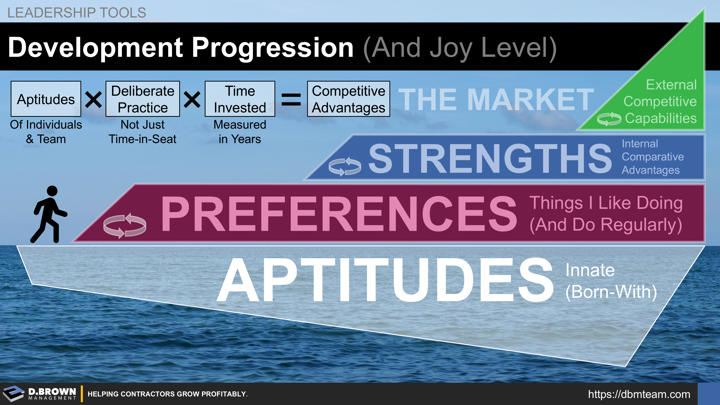The Basics of the Model:
Everyone is born with different aptitudes that can be developed over time. The most obvious of these are physical differences. For instance, in 2024, only 7 out of the 505 professional basketball players in the NBA were under 6-foot tall, while the tallest of the 2024 Team USA Olympic gymnasts was 5-1/2 feet tall. There are a whole lot of other aptitudes that must go into the foundation of an Olympic gymnast or NBA player. Fortunately, building a great life, career in construction, and contracting business doesn't require unicorn-level aptitudes. :)
We begin discovering our preferences at birth—the things we naturally like. It starts with tastes, smells, sights, and sounds, then grows into activities like playing catch or learning an instrument. Tools like Myers-Briggs, Predictive Index, DiSC, and CliftonStrengths help identify these individual preferences. They’re valuable for understanding both yourself and the people around you.
Early in life, we don’t grasp concepts like discipline or deliberate practice—we simply do what we enjoy. That’s how our aptitudes begin to turn into strengths: the things we’re naturally better at compared to others. If you have kids, you’ve likely seen this early on—some excel at math, while others may struggle with drawing, or vice versa.
Externally competitive capabilities are related to but can be different than preferences and strengths. You could be much better at math than you are at drawing but that may not translate into being top-of-class as you progress into more advanced math in high school and college. Part of it depends on the environment you are competing in. For instance, your math capabilities may be top 20% for construction project management while being in the bottom 20% for civil engineering.
Critical Points to Consider:
- Finding deep joy as you progressively build your "Perfect Life" has more to do with understanding and spending more time on your preferences. Running because you love to run is the only sustainable way to run once you are past the bottom tiers of Maslow's Hierarchy of Needs.
- The process of discovering and developing an aptitude into a skill and competency level isn't always enjoyable at first. Deliberate practice is rarely fun, especially in the earlier stages.
- Aptitudes (born with) define the upper limits of what we can develop into. When competing at the level of an elite athlete, such as the Olympics or professional sports, that upper aptitude limit will come into play. For 95% or more of the roles within a construction contractor, most of the population has enough aptitude given the right levels of standards, tools, training, development, management, and supporting systems.
- Not all preferences and strengths (internal) translate into external competitive advantages. This applies to both individuals in the job market and contractors competing for projects.
- To make a living (build a career) or build a contracting business, you must focus on both building competitive capabilities and positioning yourself where those capabilities give you the best chance of winning.
- In the real world, we rarely work alone—collaboration and interdependence is critical. It is the combined competitive strengths of the team that matter. It's the combination of leadership, management, and management systems that positions the team to win.
- Retention of talent on a team has a lot to do with keeping the individuals working within their preferences and strengths most of the time. No contractor can afford to have high turnover in this market.
Compensation:
Similar capabilities may be valued dramatically differently by different markets. That applies to building careers and a construction business. As an example, the top 10% of elementary school teachers are compensated dramatically less than the average investment banker. This is not right or wrong, but it is true.
The same is true for the industry sectors, geographies, and customers that a contractor chooses to work with. How do your outcomes compare to industry benchmarks?
The same is also true for an individual choosing which contractor to work for. Some contractors—because of a combination of their leadership, strategic market choices, management systems, and stage of growth—can pay dramatically more for a certain set of individual capabilities.
Remember that to attract and retain the best talent requires compensation to be within 10% of industry benchmark. Your business model must support that.

